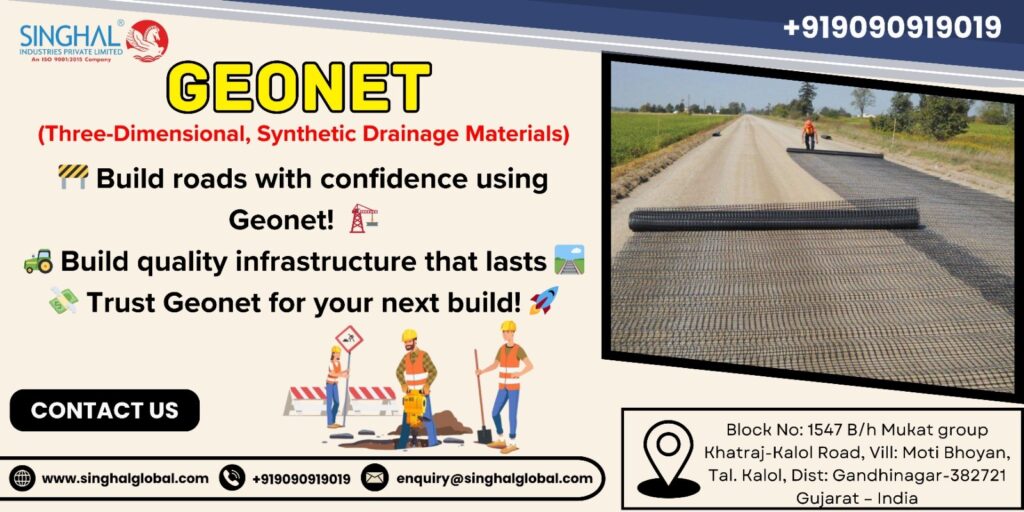When we speak about the road construction now, it is not about the concrete and asphalt only. The things we can barely see under the asphalt are so important to the life of our highways through the standard they give. The Geosynthetic material, Geonet, is one of the unsung heroes and it is quietly changing the infrastructure world in almost every corner of the world and in particular in developing countries such as India.
Due to an increased rate of infrastructure development in the different states, the need of quality sub-surface engineering is soaring through the roof. Geonet manufacturers in India are experiencing this on a first hand basis. These polymeric materials in the form of grid are not only efficient but also cost effective and friendly to the environment. And drainage is not the only thing about geonets. So, what is it?
What Exactly Is a Geonet?
Consider the net-like sheet, which is made of hardy polymers and is also stretchy. That is the simplest form of geonet. It is meant to promote transportation of the fluids (mostly water) or gases in a plane. Depending on flow requirement these materials are available in many configurations including bi-planar or tri-planar. Although that may sound technical, the essence of it is quite basic, they aid in the management of moisture underneath roads and highway. And believe us, in a rainy country such as India, where rain is very heavy and drainage facilities are not so good, that is quite a lot.
Why Geonets Are a Game-Changer in Road and Highway Construction
It is just good to know that the road you are driving on is not going to subsides, crack or buckle in the next rainy season. To a great extent, that peace of mind can be attributed to drainage systems that were installed during the construction process. That is where geonets excel.
Drainage Like Never Before
The geonets are specifically designed to swiftly transport the water away out of the roadbed. This assists in ensuring structural quality of roads because it stops erosion and soil saturation. Geonet suppliers in India serve big infrastructure works where management of water is of high priority- particularly in coastal or high rainfall areas.
Increased Load-Bearing Capacity
The inadequacy of drainage may result into deterioration of the soil below road surface and ultimately collapse the surface. The use of geonets positioned in between soil layers will permit the engineer to achieve homogenous load coefficients and therefore enhance road strength in the long run. This is one of the reasons that make Geonet prices in India as a worthful investment.
Longevity of Pavement Structures
In road engineering, there is a saying, which goes: What counts is what is beneath. A geonet assists in maintaining the intact ability of the base and sub-base layers at a longer period. The result of the mitigation of the damage caused by water is minimized repairs and prolonged pavement life-cycles, something both the highway authorities and the taxpayers would like to experience.
Real-Life Example: Mumbai-Pune Expressway Rehabilitation
Both the rehabilitation of Mumbai-Pune Expressway (one of the busiest toll roads in India) and the levelling of hillocks were done in the year 2022. The engineers used the tri-planar geonets in the median and embankments. This was aimed at certain water logging and lateral pressure during a monsoon. The result? Less erosion, better slope, stability and the ease of traffic movement even during the peak months of rain. Such projects explain why a higher percentage of government tenders are now asking geosynthetics, including geonets, to be used.
Why India Is Turning to Geonets Now
Maybe one would ask, why now? Geonets are not something new. What is different, however, is the fact that India badly needs fast infrastructure development. The roads that are being constructed today are not meant to be used in this day, but 50 years later. The necessity of smart construction material has been shooting up with a rise in axle loads, climate fluctuation, and seemingly ambitious highway networks such as Bharatmala. The other reason is cost. Thanks to local manufacturing the Geonet prices in India have become increasingly competitive. Geonet manufacturers in India are no longer dependent on imports as they can produce large quantities of products as well as develop product lines that can be used in Indian weather and climate conditions.
Personal Insight: A Civil Engineer’s Perspective
Admits the civil engineer Rajeev Kumar who works on NH-44 in Telangana: I used to be skeptical. As we used to depend on the traditional gravel drainage systems. However, when we tried out geonets, more so, in the flooding prone geographical regions, the variation was obvious. They are also quicker to install and the long term performance is bulletproof- no pun intended.”
The same can be said among the project managers dealing with high-altitude roadways in Himachal Pradesh and floodplains in Assam. It is obvious now that geonets are no longer a premium choice, but they are becoming the norm.
How to Choose the Right Geonet
Geonets are not all the same. They are selected based on various factors which include: the type of soil, anticipated water over-load as well as project needs. In the case of a high flow design tri-planar geonets are more desirable. Bi-planar ones are cheaper and adequate in the case of general highway use. India has reputable Geonet suppliers who will help in selecting the product and will even provide onsite support.
In addition, in case you are concerned about sustainability, geonets are manufactured through recycled polymers and are safe on the environment. It serves as an added advantage in government projects that tend to achieve green certifications such as GRIHA or IGBC.
Conclusion
Geonets might not seem very impressive at first sight: it is only a plastic mesh. However, once you scratch a little more, literally and figuratively, you realize that they are changing the way we construct roads. They are cheap, installable, and they deal calmly with one of the greatest adversaries of infrastructural development, water.
Therefore, the next time you are over a highway during monsoon and you do not feel like you are in a pool, then chances are there that a geonet did it.
Be you a contractor, road authority or even a curious party to wanting smarter infrastructure having awareness on this unsung hero can help you long-term in terms of saving you time, money, and maintenance wise.
Frequently Asked Questions (FAQs)
Q.1 Can Geonet be used for erosion control?
Indeed, geonets are very effective surface and sub-surface erosion control. They reduce the displacement of soils because the soil is well drained and some vegetative cover can occur whereas they are overlain with top soil.
Q.2 How thick is a typical Geonet layer?
The thickness may differ, but the geonets distributed in the market usually have 5mm to 10mm. It is necessary that the thickness be optimal given the flow requirements and the load above.
Q.3 Can Geonet be used in road construction?
Yes, Their use lies between sub-base layers to enhance the flow of water and the elimination of weakening soils and prolong life of pavements.
Q.4 How do I choose the right Geonet type?
It will depend on the draining needs of your site, traffic pressure as well as the environment. It is good to consult Geonet manufactures in India or an experienced civil engineer to be sure that you choose the right configuration and grade of polymer.









